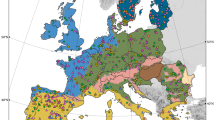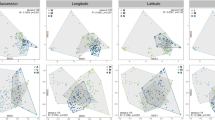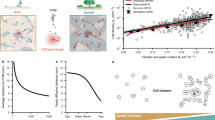Abstract
The existence of biogeographic patterns among most free-living microbial taxa has been well established, yet little is known about the underlying mechanisms that shape these patterns. Here, we examined soil bacterial β-diversity across different habitats in the drylands of northern China. We evaluated the relative importance of environmental factors versus geographic distance to a distance–decay relationship, which would be explained by the relative effect of basic ecological processes recognized as drivers of diversity patterns in macrobial theoretical models such as selection and dispersal. Although the similarity of bacterial communities significantly declined with increasing geographic distance, the distance–decay slope and the relative importance of factors driving distance–decay patterns varied across different habitats. A strong distance–decay relationship was observed in the alpine grassland, where the community similarity was influenced only by the environmental factors. In contrast, geographic distance was solely responsible for community similarity in the desert. Even the average compositional similarity among locations in the desert was distinctly lower compared with those in other habitats. We found no evidence that dispersal limitation strongly influenced the β-diversity of bacterial communities in the desert grassland and typical grassland. Together, our results provide robust evidence of habitat specificity for microbial diversity patterns and their underlying drivers. Our findings suggest that microorganisms also have multiple drivers of diversity patterns and some of which may be parallel to some fundamental processes for explaining biodiversity patterns in macroorganisms.
Similar content being viewed by others
Log in or create a free account to read this content
Gain free access to this article, as well as selected content from this journal and more on nature.com
or
References
Ahn SJ, Costa J, Emanuel JR . (1996). PicoGreen quantitation of DNA: effective evaluation of samples pre- or post-PCR. Nucleic Acids Res 24: 2623–2625.
Anderson MJ, Crist TO, Chase JM, Vellend M, Inouye BD, Freestone AL et al. (2011). Navigating the multiple meanings of beta diversity: a roadmap for the practicing ecologist. Ecol Lett 14: 19–28.
Andrew DR, Fitak RR, Munguia-Vega A, Racolta A, Martinson VG, Dontsova K . (2012). Abiotic factors shape microbial diversity in Sonoran Desert soils. Appl Environ Microbiol 78: 7527–7537.
Bardgett RD, van der Putten WH . (2014). Belowground biodiversity and ecosystem functioning. Nature 515: 505–511.
Bell G . (2001). Ecology—Neutral macroecology. Science 293: 2413–2418.
Bell T . (2010). Experimental tests of the bacterial distance-decay relationship. ISME J 4: 1357–1365.
Cambardella CA, Moorman TB, Novak JM, Parkin TB, Karlen DL, Turco RF et al. (1994). Field-scale variability of soil properties in Central Iowa soils. Soil Sci Soc Am J 58: 1501–1511.
Caporaso JG, Lauber CL, Walters WA, Berg-Lyons D, Huntley J, Fierer N et al. (2012). Ultra-high-throughput microbial community analysis on the Illumina HiSeq and MiSeq platforms. ISME J 6: 1621–1624.
Cermeno P, Falkowski PG . (2009). Controls on diatom biogeography in the ocean. Science 325: 1539–1541.
Chase JM, Leibold MA (2003). Ecological niches: linking classical and contemporary approaches. University of Chicago Press: Chicago, IL, USA.
Chesson P . (2000). Mechanisms of maintenance of species diversity. Annu Rev Ecol Syst 31: 343–366.
Cho JC, Tiedje JM . (2000). Biogeography and degree of endemicity of fluorescent Pseudomonas strains in soil. Appl Environ Microbiol 66: 5448–5456.
Chu H, Fierer N, Lauber CL, Caporaso JG, Knight R, Grogan P . (2010). Soil bacterial diversity in the Arctic is not fundamentally different from that found in other biomes. Environ Microbiol 12: 2998–3006.
Clarke KR, Ainsworth M . (1993). A method of linking multivariate community structure to environmental variables. Mar Ecol Prog Ser 92: 205–219.
Condit R, Pitman N, Leigh EG, Chave J, Terborgh J, Foster RB et al. (2002). Beta-diversity in tropical forest trees. Science 295: 666–669.
Crist TO . (1998). The spatial distribution of termites in shortgrass steppe—a geostatistical approach. Oecologia 114: 410–416.
Edgar RC, Haas BJ, Clemente JC, Quince C, Knight R . (2011). UCHIME improves sensitivity and speed of chimera detection. Bioinformatics 27: 2194–2200.
Edgar RC . (2013). UPARSE: highly accurate OTU sequences from microbial amplicon reads. Nat Methods 10: 996–998.
Ettema CH, Wardle DA . (2002). Spatial soil ecology. Trends Ecol Evol 17: 177–183.
Fierer N, Jackson RJ . (2006). From the Cover: the diversity and biogeography of soil bacterial communities. Proc Natl Acad Sci USA 103: 626–631.
Fierer N, Bradford MA, Jackson RB . (2007). Toward an ecological classification of soil bacteria. Ecology 88: 1354–1364.
Fierer N, Strickland MS, Liptzin D, Bradford MA, Cleveland CC . (2009). Global patterns in belowground communities. Ecol Lett 12: 1238–1249.
Goslee SC, Urban DL . (2007). The ecodist package for dissimilarity-based analysis of ecological data. J Stat Softw 22: 1–19.
Green J, Bohannan BJ . (2006). Spatial scaling of microbial biodiversity. Trends Ecol Evol 21: 501–507.
Green JL, Holmes AJ, Westoby M, Oliver I, Briscoe D, Dangerfield M et al. (2004). Spatial scaling of microbial eukaryote diversity. Nature 432: 747–750.
Griffiths RI, Thomson BC, James P, Bell T, Bailey M, Whiteley AS . (2011). The bacterial biogeography of British soils. Environ Microbiol 13: 1642–1654.
Hanson CA, Fuhrman JA, Horner-Devine MC, Martiny JBH . (2012). Beyond biogeographic patterns: processes shaping the microbial landscape. Nat Rev Microbiol 10: 497–506.
Harcourt AH . (1999). Biogeographic relationships of primates on South-East Asian islands. Global Ecol Biogeogr 8: 55–61.
Hijmans RJ, Cameron SE, Parra JL, Jones PG, Jarvis A . (2005). Very high resolution interpolated climate surfaces for global land areas. Int J Climatol 25: 1965–1978.
Hollister EB, Engledow AS, Hammett AJM, Provin TL, Wilkinson HH, Gentry TJ . (2010). Shifts in microbial community structure along an ecological gradient of hypersaline soils and sediments. ISME J 4: 829–838.
Horner-Devine MC, Lage M, Hughes JB, Bohannan BJM . (2004). A taxa-area relationship for bacteria. Nature 432: 750–753.
Hubbell SP . (2001) The Unified Neutral Theory of Biodiversity and Biogeography (MPB-32). Princeton University Press: Princeton, NJ, USA.
Jackson DA, Somer KM . (1989). Are probability estimates from the permutation model of Mantels test stable? Can J Zool 67: 766–769.
Kong Y . (2011). Btrim: a fast, lightweight adapter and quality trimming program for next-generation sequencing technologies. Genomics 98: 152–153.
Kruskal JB . (1964). Nonmetric multidimensional scaling: a numerical method. Psychometrika 29: 115–129.
Kuo S . (1996) Phosphorus. In: Sparks DL (ed). Methods of Soil Analysis. SSSA and ASA: Madison, WI, USA, pp 869–919.
Lauber CL, Hamady M, Knight R, Fierer N . (2009). Pyrosequencing-based assessment of soil pH as a predictor of soil bacterial community structure at the continental scale. Appl Environ Microbiol 75: 5111–5120.
Lawton JH . (1999). Are there general laws in ecology? Oikos 84: 177–192.
Legendre P, Lapointe FJ, Casgrain P . (1994). Modeling brain evolution from behavior—a permutational regression approach. Evolution 48: 1487–1499.
Legendre P, Mi XC, Ren HB, Ma KP, Yu MJ, Sun IF et al. (2009). Partitioning beta diversity in a subtropical broad-leaved forest of China. Ecology 90: 663–674.
Lewontin RC . (1970). The units of selection. Annu Rev Ecol Syst 1: 1–18.
Lê S, Julie J, Husson F . (2008). FactorMineR: an R package for multivariate analysis. J Stat Softw 25: 1–18.
Li XL, Zhang JL, Gai JP, Cai XB, Christie P, Li XL . (2015). Contribution of arbuscular mycorrhizal fungi of sedges to soil aggregation along an altitudinal alpine grassland gradient on the Tibetan Plateau. Environ Microbiol 17: 2841–2857.
Lichstein JW . (2007). Multiple regression on distance matrices: a multivariate spatial analysis tool. Plant Ecol 188: 117–131.
Lozupone CA, Knight R . (2007). Global patterns in bacterial diversity. Proc Natl Acad Sci USA 104: 11436–11440.
Maestre FT, Delgado-Baquerizo M, Jeffries TC, Eldridge DJ, Ochoa V, Gozalo B et al. (2015). Increasing aridity reduces soil microbial diversity and abundance in global drylands. Proc Natl Acad Sci USA 112: 15684–15689.
Magoc T, Salzberg SL . (2011). FLASH: fast length adjustment of short reads to improve genome assemblies. Bioinformatics 27: 2957–2963.
Martiny JBH, Bohannan BJM, Brown JH, Colwell RK, Fuhrman JA, Green JL et al. (2006). Microbial biogeography: putting microorganisms on the map. Nat Rev Microbiol 4: 102–112.
Martiny JBH, Eisen JA, Penn K, Allison SD, Horner-Devine MC . (2011). Drivers of bacterial beta-diversity depend on spatial scale. Proc Natl Acad Sci USA 108: 7850–7854.
Morlon H, Chuyong G, Condit R, Hubbell S, Kenfack D, Thomas D et al. (2008). A general framework for the distance-decay of similarity in ecological communities. Ecol Lett 11: 904–917.
Nekola JC, White PS . (1999). The distance decay of similarity in biogeography and ecology. J Biogeogr 26: 867–878.
Nemergut DR, Costello EK, Hamady M, Lozupone C, Jiang L, Schmidt SK et al. (2011). Global patterns in the biogeography of bacterial taxa. Environ Microbiol 13: 135–144.
Nemergut DR, Schmidt SK, Fukami T, O’Neill SP, Bilinski TM, Stanish LF et al. (2013). Patterns and processes of microbial community assembly. Microbiol Mol Biol Rev 77: 342–356.
Ofiteru ID, Lunn M, Curtis TP, Wells GF, Criddle CS, Francis CA et al. (2010). Combined niche and neutral effects in a microbial wastewater treatment community. Proc Natl Acad Sci USA 107: 15345–15350.
Oksanen JF, Blanchet FG, Kindt R, Legendre P, Minchin PR, O’Hara RB et al (2013). vegan: Community Ecology Package, R package, Version 2.0-10 edn.
Peay KG, Garbelotto M, Bruns TD . (2010). Evidence of dispersal limitation in soil microorganisms: isolation reduces species richness on mycorrhizal tree islands. Ecology 91: 3631–3640.
Pointing SB, Chan YK, Lacap DC, Lau MCY, Jurgens JA, Farrell RL . (2009). Highly specialized microbial diversity in hyper-arid polar desert. Proc Natl Acad Sci USA 106: 19964–19969.
Prober SM, Leff JW, Bates ST, Borer ET, Firn J, Harpole WS et al. (2015). Plant diversity predicts beta but not alpha diversity of soil microbes across grasslands worldwide. Ecol Lett 18: 85–95.
Ronca S, Ramond JB, Jones BE, Seely M, Cowan DA . (2015). Namib Desert dune/interdune transects exhibit habitat-specific edaphic bacterial communities. Front Microbiol 6: 12.
Rossi RE, Mulla DJ, Journel AG, Franz EH . (1992). Geostatistical tools for modeling and interpreting ecological spatial dependence. Ecol Monogr 62: 277–314.
Slatkin M . (1987). Gene flow and the geographic structure of natural-populations. Science 236: 787–792.
Soininen J, McDonald R, Hillebrand H . (2007). The distance decay of similarity in ecological communities. Ecography 30: 3–12.
Stegen JC, Lin XJ, Konopka AE, Fredrickson JK . (2012). Stochastic and deterministic assembly processes in subsurface microbial communities. ISME J 6: 1653–1664.
Stegen JC, Lin XJ, Fredrickson JK, Chen XY, Kennedy DW, Murray CJ et al. (2013). Quantifying community assembly processes and identifying features that impose them. ISME J 7: 2069–2079.
Talbot JM, Bruns TD, Taylor JW, Smith DP, Branco S, Glassman SI et al. (2014). Endemism and functional convergence across the North American soil mycobiome. Proc Natl Acad Sci USA 111: 6341–6346.
Tedersoo L, Bahram M, Toots M, Diedhiou AG, Henkel TW, Kjoller R et al. (2012). Towards global patterns in the diversity and community structure of ectomycorrhizal fungi. Mol Ecol 21: 4160–4170.
Trangmar BB, Yost RS, Uehara G . (1985). Application of geostatistics to spatial studies of soil properties. Adv Agron 38: 45–94.
Tuomisto H, Ruokolainen K, Yli-Halla M . (2003). Dispersal, environment, and floristic variation of western Amazonian forests. Science 299: 241–244.
Vellend M . (2010). Conceptual synthesis in community ecology. Q Rev Biol 85: 183–206.
Wang C, Wang X, Liu D, Wu H, Lv X, Fang Y et al. (2014). Aridity threshold in controlling ecosystem nitrogen cycling in arid and semi-arid grasslands. Nat Commun 5: 4799.
Wang J, Shen J, Wu Y, Tu C, Soininen J, Stegen JC et al. (2013). Phylogenetic beta diversity in bacterial assemblages across ecosystems: deterministic versus stochastic processes. ISME J 7: 1310–1321.
Wang Q, Garrity GM, Tiedje JM, Cole JR . (2007). Naive Bayesian classifier for rapid assignment of rRNA sequences into the new bacterial taxonomy. Appl Environ Microbiol 73: 5261–5267.
Wang X, Van Nostrand JD, Deng Y, Lu X, Wang C, Zhou J et al (2015). Scale-dependent effects of climate and geographic distance on bacterial diversity patterns across northern China’s grasslands. FEMS Microbiol Ecol 91: fiv133.
Woodcock S, Curtis TP, Head IM, Lunn M, Sloan WT . (2006). Taxa-area relationships for microbes: the unsampled and the unseen. Ecol Lett 9: 805–812.
Yergeau E, Newsham KK, Pearce DA, Kowalchuk GA . (2007). Patterns of bacterial diversity across a range of Antarctic terrestrial habitats. Environ Microbiol 9: 2670–2682.
Zinger L, DPH Lejon, Baptist F, Bouasria A, Aubert S, Geremia RA et al. (2011). Contrasting diversity patterns of Crenarchaeal, bacterial and fungal soil communities in an Alpine landscape. PLoS One 6: e19950.
Zinger L, Boetius A, Ramette A . (2014). Bacterial taxa-area and distance-decay relationships in marine environments. Mol Ecol 23: 954–964.
Acknowledgements
We thank all the members of the Shenyang Sampling Campaign Team from the Institute of Applied Ecology, Chinese Academy of Sciences for their assistance during field sampling. We gratefully thank Jennifer Martiny for helpful suggestions and comments on the earlier version of the manuscript. We also greatly appreciate the three anonymous reviewers and the editors of this journal for giving important comments that significantly improved the quality of the paper. This work was financially supported by the Strategic Priority Research Program of the Chinese Academy of Sciences (XDB15010401), the General Program of the National Natural Science Foundation of China (31670457), the Office of the Vice President for Research at the University of Oklahoma, the Collaborative Innovation Center for Regional Environmental Quality.
Author contributions
XW, ZW, XL and XH designed the study, XW, XL performed the experiment, XW analyzed the data and XW, XL, JY, XH and JZ wrote the paper. All coauthors participated in discussions at the working group meetings and edited the manuscript.
Author information
Authors and Affiliations
Corresponding author
Ethics declarations
Competing interests
The authors declare no conflict of interest.
Additional information
Supplementary Information accompanies this paper on The ISME Journal website
Supplementary information
Rights and permissions
About this article
Cite this article
Wang, XB., Lü, XT., Yao, J. et al. Habitat-specific patterns and drivers of bacterial β-diversity in China’s drylands. ISME J 11, 1345–1358 (2017). https://doi.org/10.1038/ismej.2017.11
Received:
Revised:
Accepted:
Published:
Issue date:
DOI: https://doi.org/10.1038/ismej.2017.11
This article is cited by
-
Nitrogen and water additions with or without mowing altered soil microbial community characteristics in a semi-arid steppe
Ecological Processes (2025)
-
Host selection is not a universal driver of phyllosphere community assembly among ecologically similar native New Zealand plant species
Microbiome (2025)
-
Transitions within agroecosystems impact protists diversity and soil multifunctionality
Communications Earth & Environment (2025)
-
Rare and abundant taxa in Artemisia desertorum rhizosphere soils demonstrate disparate responses to drought stress
Advanced Biotechnology (2025)
-
Rare Taxa in the Rhizosphere Primarily Influence Nitrogen Dynamics in Plantations in Northeastern China, With Minimal Impact on Carbon and Phosphorus
Journal of Soil Science and Plant Nutrition (2025)



